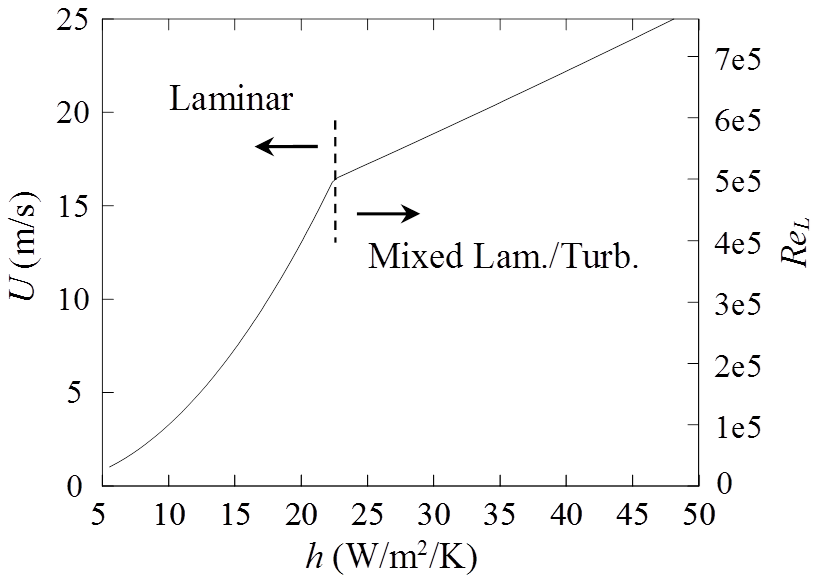Forced
convection from flat plate
The function PlateNuT( ) is written to return either the laminar
or mixed laminar/turbulent forced convection correlation results for isothermal
surfaces depending on the value of ReL. As an illustration,
the influence of air speed on the convection coefficient of an isothermal plate
can be investigated with PlateNuT( )
using the following commands:
Ts=50+273.15; Tinf=20+273.15; U=1; L=0.5; ReCrit=5e5;
load Air.dat
Tf = (Ts+Tinf)/2;
U = linspace(1,25,100);
[h NuL ReL] = PlateNuT(U,L,ReCrit,Air,Tf);
ax = plotyy(h,U,h,ReL);
axis(ax(1),[5 50 0 U(end)]);
axis(ax(2),[5 50 0 ReL(end)]);
 Notice that
at an air speed of U=16.4 m/s, the Reynolds number is at the transition value
(rule of thumb) between laminar and turbulent flow for a smooth plate.
Therefore, the convection coefficient is calculated from the laminar flow
correlation at air speeds less than 16.4 m/s, while at greater speeds the mixed
flow correlation is used.
Notice that
at an air speed of U=16.4 m/s, the Reynolds number is at the transition value
(rule of thumb) between laminar and turbulent flow for a smooth plate.
Therefore, the convection coefficient is calculated from the laminar flow
correlation at air speeds less than 16.4 m/s, while at greater speeds the mixed
flow correlation is used.
 Notice that
at an air speed of U=16.4 m/s, the Reynolds number is at the transition value
(rule of thumb) between laminar and turbulent flow for a smooth plate.
Therefore, the convection coefficient is calculated from the laminar flow
correlation at air speeds less than 16.4 m/s, while at greater speeds the mixed
flow correlation is used.
Notice that
at an air speed of U=16.4 m/s, the Reynolds number is at the transition value
(rule of thumb) between laminar and turbulent flow for a smooth plate.
Therefore, the convection coefficient is calculated from the laminar flow
correlation at air speeds less than 16.4 m/s, while at greater speeds the mixed
flow correlation is used.